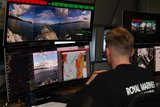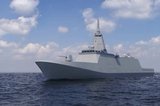Boeing maritime surveillance demonstrator takes off
The Maritime Surveillance Aircraft (MSA) demonstrator under development by Boeing has completed its first flight from Toronto’s Pearson International Airport. The four hour flight, conducted by Boeing teammate Field Aviation, was conducted to verify airworthiness.
Boeing is developing the demonstrator as a low-risk and cost-effective maritime surveillance solution designed for search and rescue, anti-piracy patrols and coastal and border security.
MSA uses technologies developed for Boeing's P-8A Poseidon programme to provide multi-mission surveillance capabilities. The baseline configuration features an Active Electronically Scanned Array multi-mode radar, an Electro/Optical/Infrared sensor, Electronic Support Measures, a Communications Intelligence sensor and Automated Identification System.
Flights will continue over the coming two months, before the demonstrator is flown to a Boeing facility in Seattle where the MSA mission systems will be installed and tested.
Field Aviation Pilot Craig Tylski said: ‘We accomplished everything we set out to achieve. The aerodynamic performance was right on the money and even with the additional aerodynamic shapes, such as the radome, the demonstrator performed like a normal aircraft. The control and handling were excellent.’
More from Naval Warfare
-
![NATO tests use of “undetectable, jam-proof” laser communication in maritime scenarios]()
NATO tests use of “undetectable, jam-proof” laser communication in maritime scenarios
As part of its effort to better prepare its capabilities for operations in contested and congested scenarios, NATO evaluated a Lithuanian ship-to-ship terminal designed to not be susceptible to enemy interference.
-
![US Navy advances with the Harpoon Service Life Extension Programme]()
US Navy advances with the Harpoon Service Life Extension Programme
The US Navy plans to improve Harpoon’s anti-ship and land attack capabilities by equipping the missiles with sensors and technologies required for succeeding in future battlespace.
-
![Mitsubishi eyes future with Australia’s Mogami selection]()
Mitsubishi eyes future with Australia’s Mogami selection
With Australia’s selection of the Mogami-class for Project Sea 3000, Mitsubishi is investigating local production in the next decade as potential export opportunities emerge.
-
![Thales’ new Sonar 76Nano could equip UK Royal Navy on anti-submarine warfare missions]()
Thales’ new Sonar 76Nano could equip UK Royal Navy on anti-submarine warfare missions
The new sonar is designed to equip uncrewed underwater vessels, with the potential to be used by the Royal Navy for its Atlantic Bastion and Atlantic Net missions.
-
![Hanwha wins Australian government approval to increase its stake in Austal]()
Hanwha wins Australian government approval to increase its stake in Austal
The contract would mean the two shipbuilders can collaborate strategically and enhance shipbuilding capabilities in Western Australia.























